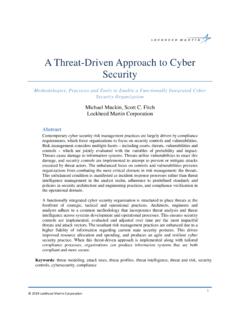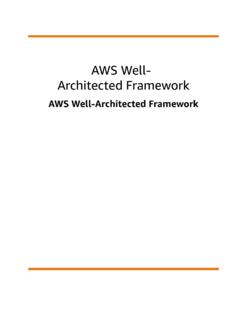Transcription of Integrated Care Systems: design framework - NHS England
1 Classification: Official Publications approval reference: PAR642. Integrated Care Systems: design framework Version 1, June 2021. Contents Introduction and summary 2. Context 6. The ICS Partnership 8. The ICS NHS body 12. People and culture 16. Governance and management arrangements 19. The role of providers 27. Clinical and professional leadership 33. Working with people and communities 35. Accountability and oversight 37. Financial allocations and funding flows 40. Data and digital standards and requirements 47. Managing the transition to statutory ICSs 49. Conclusion 54. 1 | Contents Introduction and summary Everyone across the health and care system in England , in the NHS, local authorities and voluntary organisations, has made extraordinary efforts to manage the COVID-19 pandemic and deliver the vaccination programme while continuing to provide essential services.
2 We still face major operational challenges: tackling backlogs; meeting deferred demand, new care needs, changing public expectations; tackling longstanding health inequalities; enabling respite and recovery for those who have been at the frontline of our response; and re-adjusting to a post-pandemic financial regime. The intensity of the incident may have abated, but we are still managing exceptional pressure and uncertainty, with differential impacts across the country. As we respond, Integrated Care Systems (ICSs) will play a critical role in aligning action between partners to achieve their shared purpose: to improve outcomes and tackle inequalities, to enhance productivity and make best use of resources and to strengthen local communities.
3 Throughout the pandemic our people told us time and time again that collaboration allowed faster decisions and better outcomes. Co-operation created resilience. Teamwork across organisations, sectors and professions enabled us to manage the pressures facing the NHS and our partners. As we re-focus on the ambitions set out in the NHS Long Term Plan, it is imperative we maintain our commitment to collaborative action, along with the agility and pace in decision-making that has characterised our response to the pandemic. We want to do everything we can to support this nationally and give you the best chance of making effective and enduring change for the people you serve.
4 This means seizing the opportunities presented by legislative reform to remove barriers to Integrated care and create the conditions for local partnerships to thrive. And it means asking NHS leaders, working with partners in local government and beyond, to continue developing Integrated Care Systems during 2021/22, and preparing for new statutory arrangements from next year. 2 | Integrated Care Systems: design framework We know this is a significant ask. This document sets out the next steps. It builds on previous publications1 to capture the headline ambitions for how we will expect NHS leaders and organisations to operate with their partners in ICSs from April 2022.
5 It aims to support you as you continue to deliver against the core purpose of ICSs and put in place the practical steps to prepare for their new arrangements that we expect to be enabled by legislation in this Parliamentary session. The ambition for ICSs is significant and the challenge for all leaders within systems is an exciting one. Successful systems will align action and maintain momentum during transition, with systems continuing to make progress in improving outcomes and supporting recovery while embedding new arrangements for strategic planning and collective accountability across partners. The collective leadership of ICSs and the organisations they include will bring teams with them on that journey and will command the confidence of NHS and other public sector leaders across their system as they deliver for their communities.
6 The level of ambition and expectation is shared across all ICSs and there will be consistent expectations set through the oversight framework , financial framework national standards and LTP commitment with ICSs adjusting their arrangements to be most effective in their local context. It is important that this next year of developing ICSs and implementing statutory changes, if approved by Parliament and once finalised, builds on progress to date and the great work that has already taken place across the country. Effective transition will see high performing systems taking their existing ways of working and creatively adapting these to the new statutory arrangements.
7 It is an acceleration, in the current direction. This document begins to describe future ambitions for: the functions of the ICS Partnership to align the ambitions, purpose and strategies of partners across each system2. the functions of the ICS NHS body, including planning to meet population health needs, allocating resources, ensuring that services 1 Integrating care: next steps to building strong and effective Integrated care systems and Integration and innovation: working together to improve health and social care for all NHS Operational Planning and Contracting Guidance 2 Guidance on the Partnership will be developed by DHSC with local government, NHS and other stakeholders.
8 Expectations described here are based on the proposals set out in the Government's white paper and initial discussions with local government partners. 3 | Integrated Care Systems: design framework are in place to deliver against ambitions, facilitating the transformation of services, co-ordinating and improving people and culture development, and overseeing delivery of improved outcomes for their population the governance and management arrangements that each ICS NHS. body will need to establish to carry out those functions including the flexibility to operate in a way that reflects the local context through place-based partnerships and provider collaboratives the opportunity for partner organisations to work together as part of ICSs to agree and jointly deliver shared ambitions key elements of good practice that will be essential to the success of ICSs, including strong clinical and professional leadership, deep and embedded engagement with people and communities.
9 And streamlined arrangements for maintaining accountability and oversight the key features of the financial framework that will underpin the future ambitions of systems, including the freedom and mechanisms to use resource flexibly to better meet identified needs and to manage financial resources at system level the roadmap to implement new arrangements for ICS NHS bodies by April 2022 to establish new organisations, appoint leadership teams to new statutory organisations and to ensure that people affected by change are offered a smooth transition that allows them to maintain focus on their critical role in supporting recovery from the pandemic. Further information or guidance, developed through engagement with systems and stakeholders, will be made available to support detailed planning.
10 Where relevant, this will follow the presentation of proposed legislation to Parliament. We have heard a clear message from systems that they are looking for specificity about the consistent elements of how we will ask them to operate, alongside a high degree of flexibility to design their ways of working to best reflect local circumstances. This document aims to achieve both: to be clear and specific on the consistent requirements for systems and to define the parameters for the tailoring to local circumstances which is key to success. It goes beyond likely minimum statutory requirements and sets out the ambition from NHS England and NHS. 4 | Integrated Care Systems: design framework Improvement3 on what will be necessary for systems to be successful as they lead our recovery from the pandemic and the wider delivery of the Long Term Plan.
















